-
This article has been translated from the original Japanese content.
-
This interview was conducted before the game was released.
In this 19th volume of Ask the Developer, an interview series in which developers convey in their own words Nintendo’s thoughts about creating products and the unusual details they hone in on, we’re talking to the developers behind the Donkey Kong Bananza game, a Nintendo Switch™ 2 game that launches on Thursday, July 17.
Check out the rest of the interview
Part 2: Voxel technology
The concept of destruction is central to this game. How did the team go about exploring and implementing it?
Tanaka: Actually, the programming team had already been researching smashing mechanics even before development began.
So it wasn’t that the concept of destruction came first, and then you built a mechanic around it?
Tanaka: No. Shortly after Super Mario Odyssey was released, we started running technical experiments with the idea of, “What kind of game do you get if everything in the environment is destructible?”
Motokura: We even tried sticking arms on a Goomba.
Tanaka: That’s right, we did. (Laughs) In Super Mario Odyssey, there’s a boss called Knucklotec who attacks Mario with giant hands. The programmer who created him tried attaching those arms to a Goomba as an experiment. The Goomba could smash terrain, tear off pieces to use as weapons, and throw them.
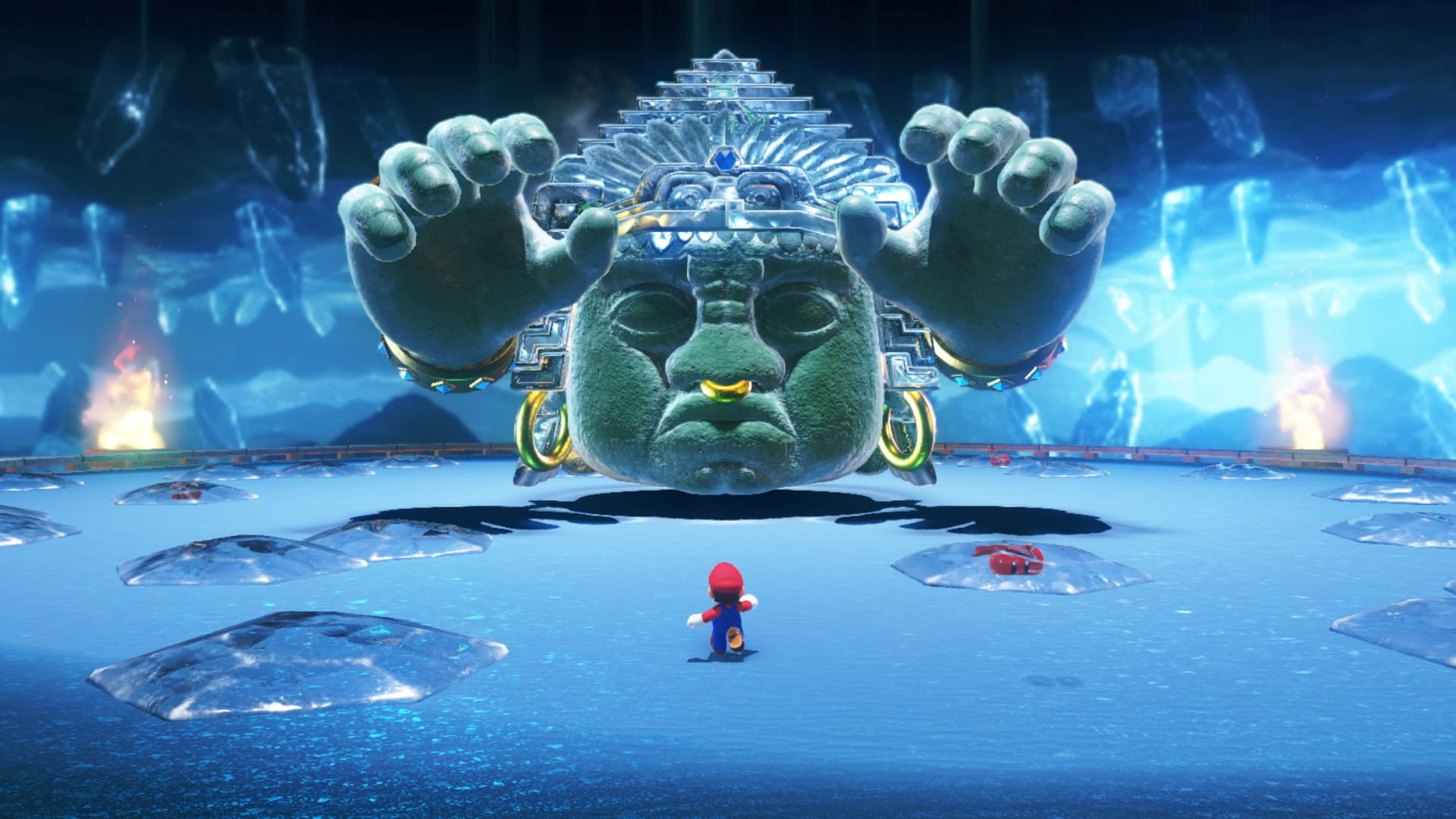
Those actions felt surprisingly satisfying, and we got a sense that this destruction-based gameplay could be a compelling core mechanic.
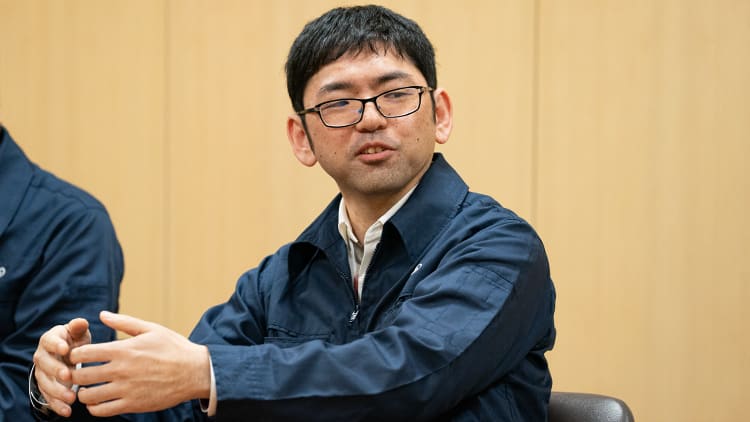
Motokura: The results of our tests showed that destruction-based gameplay could work, and it was a good match for Donkey Kong’s enormous strength. We felt that the concept and the core gameplay had clicked into place.
So your efforts to define a new Donkey Kong aligned with the smashing mechanics you’d been exploring at the same time.
Motokura: That’s right. But truth be told, that was just the first step in a long journey. (Laughs)
We did a ton of testing. We wanted to incorporate actions like tearing off part of the terrain and swinging it, resulting in further destruction, like smashing something to reveal a new path. At the core, we wanted to create a game where the player’s actions trigger reactions, and that continuous interaction keeps moving the gameplay forward.
Tanaka: We decided pretty early on that if we were serious about pursuing that kind of gameplay, we should use voxel technology.
Voxel technology? What exactly is that?
Tanaka: Let’s start with pixel art, which I think most people are familiar with. Pixel art is made up of lots of tiny squares arranged on a flat surface, and by varying the colors of those squares, they combine to form a single image. While each square in a two-dimensional image is called a pixel, when the same idea is extended into three dimensions, each cube is called a voxel. It’s hard to put into words, so we created this diagram to clearly explain it to the development team since it’s such an important element in this game.
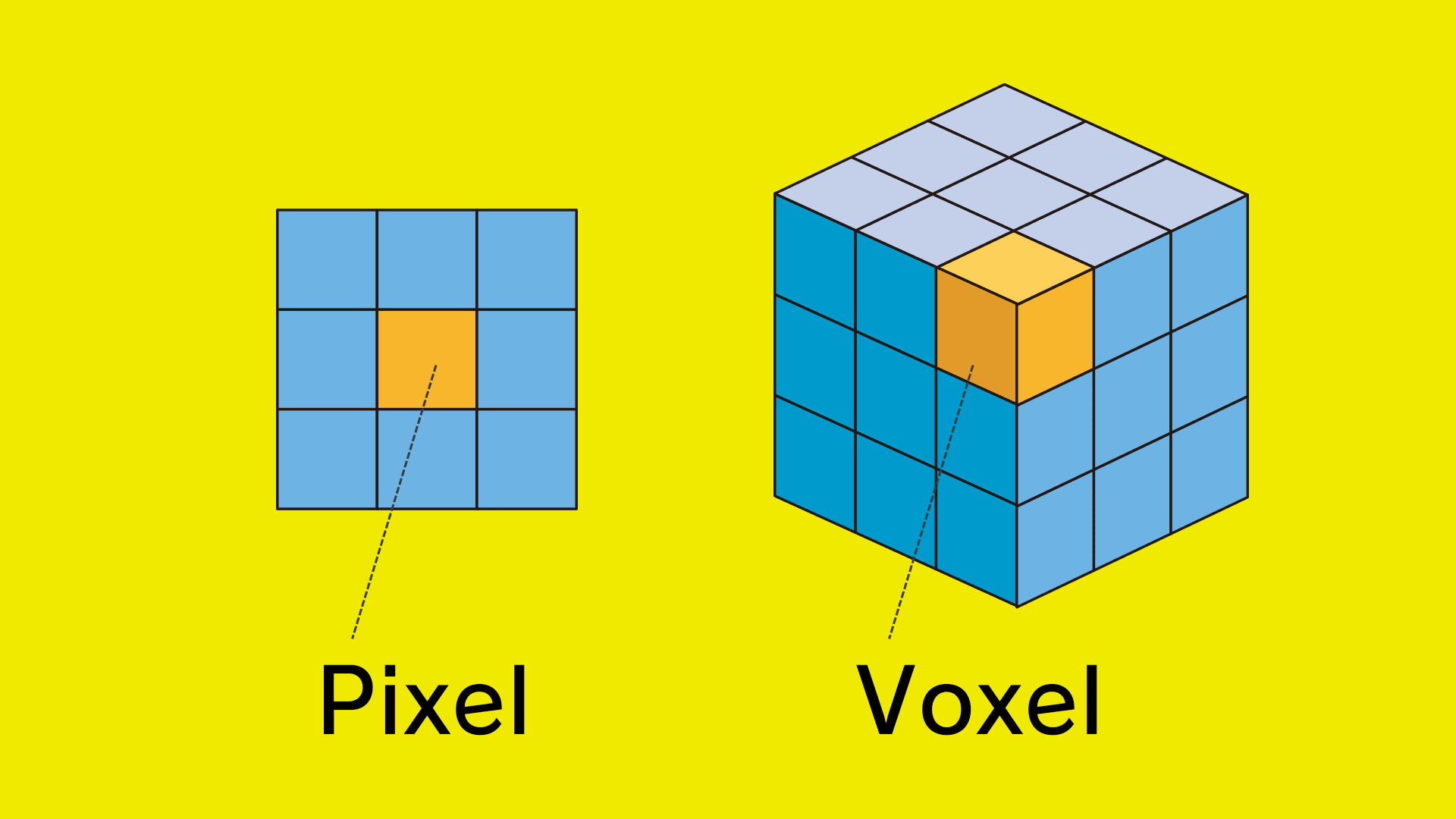
Motokura: Since our team’s been creating 3D action games for a long time, we thought that combining what we did in 3D Mario games with voxel-based destruction would naturally lead to a completely new kind of gameplay.
Takahashi: Everything in this game is made out of voxels, including the terrain and the enemies. And it’s the voxel-based terrain that enables the core gameplay feature where you can destroy virtually everything in sight.
Tanaka: But once we’d decided to go all in with voxels, I instinctively knew it was going to be difficult.
That’s because the development environment for voxel-based games wasn’t readily available to everyone on our team. So first we needed to consider how to go about creating the voxels themselves.
I see. You referred to voxels as cubes, but the terrain and enemies in this game don’t look especially cube-like, do they?
Tanaka: Voxels are really just part of the internal structure, so we focused on making sure players wouldn’t notice them while playing. The biggest reason we chose voxels was their flexibility, as they let us define the appearance and material of each part of the terrain individually. It’s not just that the terrain is destructible – it also has various different properties. Take sand, for example. It’s soft, sticks to walls when thrown, and is hard to climb because you tend to slip. There are also visual differences, such as desert sand being yellowish and shoreside sand being whiter in color. The development team collectively referred to different substances, such as white sand, red soil, and gray rock, as “materials.” Each has its own unique physical properties and appearance. Each voxel in the game is assigned one of these materials.
Watanabe: Put simply, placing voxels with the soil material generates terrain made of soil. Adding voxels with the grass material on top of that then turns it into terrain with grass growing over soil. Terrain created in this way can be destroyed on a voxel-by-voxel basis.
Takahashi: Typically, in game development, 3D levels are created by first building polygon models and then applying textures to each of them. But for this game, as soon as we had our voxel modeling tools, things became much more convenient. We could freely combine voxels and materials to build terrain and then test it out immediately in-game. This let us quickly experiment and iterate when building Layers. That’s one of the great things about voxel technology, I think. Though it must have been an absolute nightmare for the programmers building the tools. (Laughs) Thanks to the creation of this toolset, we were able to craft Layers that feel truly unique to this game, with terrain that features a rich variety of visual styles and physical properties, along with underground areas and fully destructible environments, down to the smallest detail.
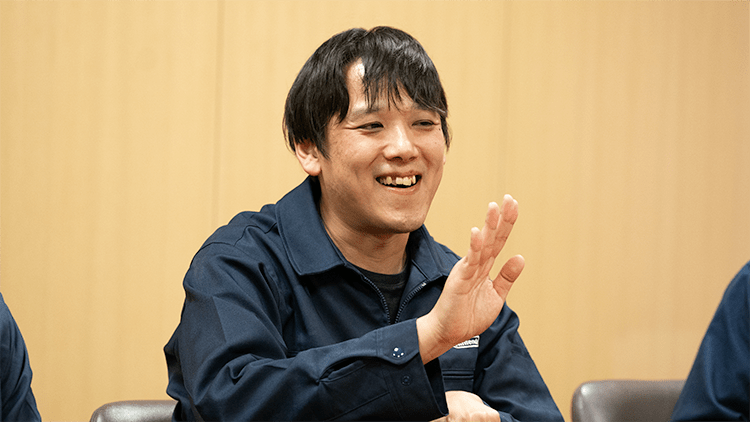
I see. Hearing you talk about it, I can really see how this technology is a perfect match for gameplay built around the concept of destruction. By the way, was this the first time your team incorporated voxel technology?
Motokura: Actually, we also used voxel technology in Super Mario Odyssey to make the terrain interactive. For example, the cheese rocks in Luncheon Kingdom, or the snow you can plow through in Snow Kingdom.
That said, in Super Mario Odyssey, we started using voxels midway through development, so the areas where we could apply them were limited. But the trial and error we went through back then directly led to what we were able to do in Donkey Kong Bananza.
Speaking of what’s changed since Super Mario Odyssey, Donkey Kong Bananza is being released as a Nintendo Switch 2 game. Given the development timeline, was it planned as a Switch 2 game from the beginning?
Motokura: We originally began developing Donkey Kong Bananza on Nintendo Switch, but we ran into some challenges. I think it was around 2021 when we started to think about moving development to Switch 2.
Watanabe: We first looked into how we could upgrade what we’d originally built for Switch to take advantage of Switch 2. One of the most obvious improvements was that we could place far more objects in the environment than before. Being able to place more objects in the terrain didn’t just enhance the game’s visual richness. More importantly, it increased the amount of things players could destroy, which amplified the exhilaration of being able to demolish anything and everything. That went hand in hand with the game’s core concept of destruction. It convinced us that this game would be even more fun if we developed it for Switch 2.
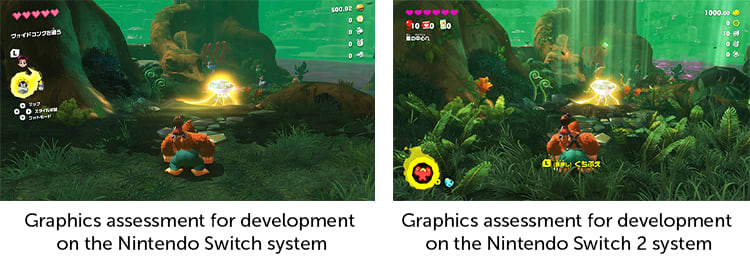
Tanaka: From a programmer’s perspective, voxel technology is well-suited for creating gameplay centered around destruction. However, it also uses a lot of system memory, and we faced the challenge of Switch not having enough to support everything we wanted to do. I’ll explain with some simple arithmetic. If you’re asked to double the size of a 1 × 1 pixel image in both width and height, you end up with a 2 × 2 image, which means four times as many pixels. But when you do the same with voxels, you’ve got width and height, but also depth to contend with. So, doubling all three dimensions gives you 2 × 2 × 2, or eight times the data. It may sound simple to just “double something,” but the reality is that memory usage, voxel density, and all kinds of processes end up gobbling up eight times the resources. It was clear that the memory available on Switch would struggle to handle that load, and we felt that manifesting the huge volume of terrain that we did in this game might have been unachievable on that platform. With the move to Switch 2, we gained not only more memory but also greater processing capacity. That gave us the freedom to incorporate gameplay ideas we’d previously abandoned because they were too demanding. When we got down to trying it, we discovered that not only could it handle the heavy processing requirements, but it also ran at 60 fps (10). Things we’d given up on, like explosions flinging large objects or causing them to collapse, were now possible. Designers could also place as many objects as they wanted. There were so many moments when we thought to ourselves, “Now we can really do this.”
(10) Frames per second. This value represents the number of images (frames) that are displayed per second on the game screen. Thirty fps means that 30 images are displayed per second, while 60 fps indicates 60 images per second. The higher the number, the smoother the image.
Watanabe: As well as running at a smooth 60 fps, the core gameplay of smashing got way more satisfying.
The physics of smashing involve lots of things all happening at once. Donkey Kong throws a punch, the terrain and objects break apart, and visual effects show debris flying outward. All of that is packed into a single moment. At 30 fps, we couldn’t fully capture everything that happens in that instant. But at 60 fps, we saw that sense of destruction coming through much more clearly. We thought to ourselves, “Now we’ve got something seriously satisfying!” Not only did Switch 2 enable the game to run well, it unlocked the game’s full potential – no, it made the game possible.
I see. So, the way everything’s expressed in that brief moment really has a strong impact on the gameplay experience.
Watanabe: We talked about voxel technology earlier, and I think for most people, the term “voxel game” brings to mind visuals made of stacked cubes. That’s exactly why we as designers aimed to create rich and dense visuals that don’t look like voxels at all – something that players will see and think, “Wait, you can destroy this?” We believed that by creating dense visuals with a sense of realism that weren’t obviously made of voxels, players would be genuinely surprised when they realized the environment was destructible. That surprise would make the sense of destruction all the more convincing and satisfying. This wasn’t something the designers could handle on their own. We worked closely with the programmers, running test after test to figure things out together. Since voxel technology has yet to be fully explored, we had to figure things out as we went along, experimenting with both the mechanics and the design.
Tanaka: The technology that enables voxel-based shapes to appear smooth already existed, but we figured that if we were going to do it right, we should push the visuals to have a strong sense of realism.
Of course, actually getting that to work took an obscene amount of effort from both the designers and the programmers. (Laughs)
Watanabe: Since destruction is such a central concept in the game, we had to pay attention not just to how things looked, but also to the physical properties of the terrain itself.
By physical properties, you mean the “materials” you mentioned earlier, right?
Watanabe: Exactly. We focused not just on the surface of the terrain, but also what lies beneath it once it breaks. We designed the terrain so that when it’s destroyed or carved out, its appearance and physical properties change in ways that make the sense of destruction feel more convincing.
Tanaka: For example, if you strip away the grass, it exposes the soil underneath. If you strike a rock, cracks begin to form. And if you dig near water, the ground gradually darkens as moisture seeps in.
We carefully defined the effects each material produces when it breaks, refining every detail to make the destruction feel as realistic and convincing as possible.
Kubo: We also poured a lot of effort into the sound effects to make the sense of destruction feel satisfying and responsive. It wasn’t just about using loud or dramatic sounds. For instance, players will hear the sound of basic materials like rocks breaking thousands of times during play. So, we aimed for sounds that are pleasant to the ears without being tiring or repetitive. To that end, we recorded sound effects by hand, capturing the textures of materials like rock and sand. Recording everyday sounds like this is often referred to as Foley. We recorded lots of variations so the sound would vary depending on how the material was destroyed, instead of always sounding the same. We also added subtle randomness through programming and fine-tuned the sounds to make sure they weren’t too loud or high-pitched. Meanwhile, for special objects that show up later in the game, we emphasized fun and flashy sounds. We hope players will find them satisfying. We recorded all kinds of material sounds using Foley techniques, including those of fruits. There’s even a dedicated sound for hitting a watermelon. It was about more than just making it sound hard or soft. When players hit it, we wanted it to sound delicious! (Laughs)
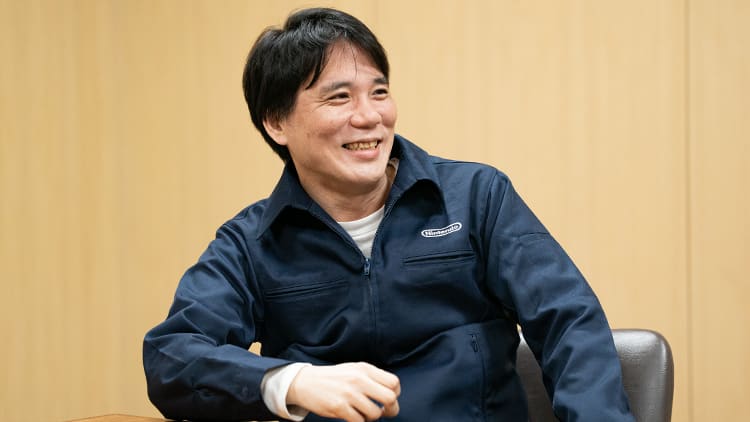
I’m curious to know how a delicious watermelon sounds. (Laughs)
Motokura: We put a lot of thought into the sound and visual effects, and into making the destruction feel satisfying. I think players will realize the fun of smashing things the moment they start playing. It’s a simple, intuitive kind of fun that even newcomers to action games will appreciate. Compared to Super Mario Odyssey, I think the game’s core appeal and sense of exhilaration can be felt more immediately.
Takahashi: This game isn’t just about smashing things. Continuity is another important concept we focused on. For example, there’s a move called the Hand Slap, where Donkey Kong slams the ground. That move also acts like a sonar, revealing objects buried nearby. You might spot something glowing on the other side of a wall, and when you break through the wall and dig up the fossil buried there, you might then come upon a hidden area beyond that, leading to even more discoveries.
When creating Layers, we went beyond surface level design. We crafted them with continuity in mind, so that breaking one thing would naturally lead to the next.
The sense of continuity that comes from breaking things really feels unique to this game. But if players can destroy almost anything, wasn’t it a challenge to design levels that don’t fall apart?
Takahashi: It certainly was, and that’s exactly why they needed so much thought put into them. The Layers are fun, even if you just play through them normally, but we designed them so that even if the destruction causes their structure to collapse, it’s all part of the fun. In most games, level design is a bit like designing a course. You’ve got a main route you want players to follow, and you build paths to guide them along it. But in this game, even those paths can be destroyed. For example, the “correct” way to get a golden banana – aka Banandium Gem – might be to use the Bananza transformations to smash through a concrete wall. But if you instead dig a tunnel and sneak around to grab it from behind, that’s equally viable. Designing levels with that kind of flexibility in mind was a huge challenge, but I think the ability to be crafty like that is part of what makes this game so fun.
Kubo: It must’ve been rather tough, designing all those hidden underground areas.
Watanabe: The levels in this game are really expansive, both vertically and horizontally, so we talked about how we could ensure players wouldn’t get lost.
Motokura: In 3D Mario games, the goal is often placed up high. But since digging and breaking things are the main actions in this game, the player naturally moves downward instead. We kept tweaking the design, using various mechanisms and the terrain to gently guide the player, balancing the exhilaration of destroying everything with the satisfaction you get when you complete a Layer.
Source link

